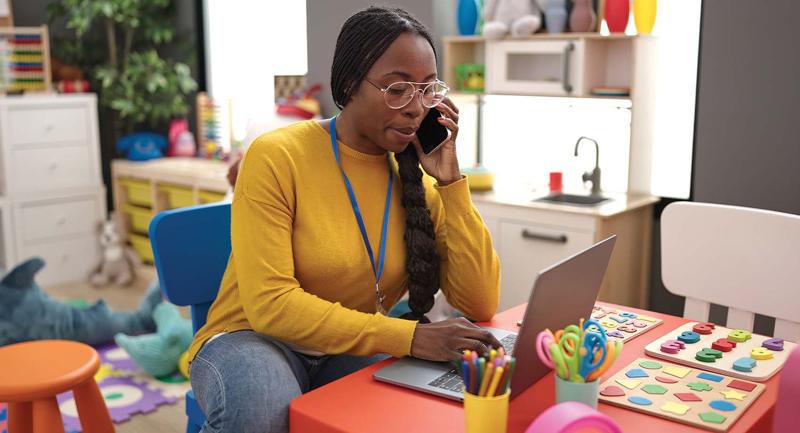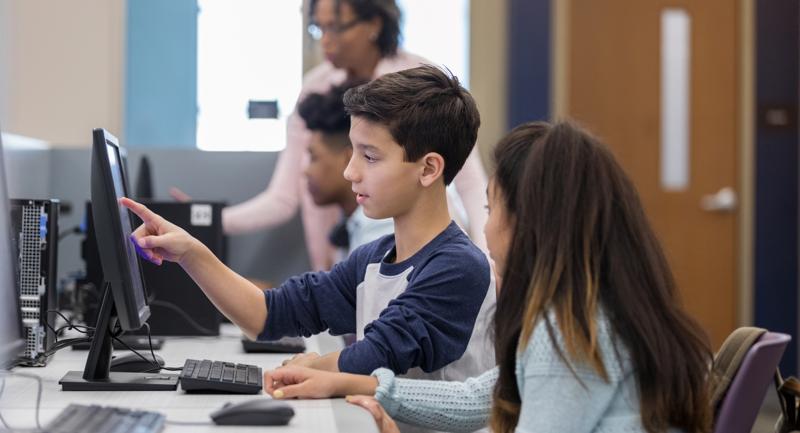I served as a middle and high school English teacher for the first 10 years of my career in education. One lesson still stands out to me: I vividly remember standing alone in front of a classroom of students, trying to get them started on creating their own blogging site so they could have an authentic audience for their writing—and failing miserably. I had a horrible feeling in the pit of my stomach as I was bombarded by questions about not only the assignment itself, but also how to navigate areas of the blog platform that looked entirely different in "student view." I only had 50 minutes with the class before the bell rang so I'd have to either start the whole process over again or scratch the lesson and pivot to something nontechnical.
To run into so many issues was disheartening. I had spent weeks working late into the night searching for an online platform that would allow my students to showcase their writing while keeping them safe from potentially harmful or inappropriate public commenting.
While I ended up regrouping after that day, taking another week to dig into the platform from the student side, and eventually trying again (with success this time), the scenario could have easily frustrated me to the point that I never wanted to use computers for writing assignments again. This is why, just a short time later, I was excited to discover a job opening for an educational technology coach in a neighboring district. I had never heard of the role before, but after reading the description, I was hooked. I never wanted another teacher to have to go through the long and tedious process of researching a new technology-rich strategy and trying to implement it alone in a room full of students with precious instructional minutes ticking away.
I eventually landed an edtech coaching role at a high school in a neighboring district. With a flexible schedule, I could fully mix into the culture of the school and support any teacher at any time. I was soon spending almost all my time inside classrooms—learning about the projects teachers wanted their students to create, coplanning with teachers to reimagine units they had been teaching the same way for many years, and supporting teachers as they tried a new resource or strategy. I was giving the teachers at my school something I didn't have when I taught.
Fast forward I won't tell you how many years and I was working as a district technology director. In response to the North Carolina Digital Learning Initiative in 2016, my district had made it a priority to fund an edtech coach for each elementary, middle, and high schools. Having this role in place was one of the top reasons we were able to transition so quickly and effectively into remote learning when the pandemic shut schools down in March 2020. The teachers in our district didn't skip a beat, and those who needed extra guidance knew exactly who to call for support with transitioning their lesson plans to a virtual environment. Our edtech coaches worked with large groups of teachers from our school district, providing professional learning on how to run virtual meetings; supported the creation of instructional schedules that included whole-class, small-group, and one-on-one instruction; and worked individually with teachers who wanted to talk through their lessons plans. These coaches had become and still are an invaluable resource.
How to Utilize an Edtech Coach
During the pandemic, emergency federal funding enabled many schools to provide devices to every student, purchase new programs, and upgrade their infrastructures. As students started returning to school, there was a great deal of excitement that this influx of hardware and software would translate to more engaging, technology-rich learning environments when schools returned to in-person instruction. But, as I have seen in my current role at the North Carolina Department of Public Instruction, some schools are moving away from using technology altogether. This trend may be an attempt to reduce screentime for students or an overcorrection by schools who saw test scores drop after students were required to participate in remote learning. We have to keep in mind, though, that the way many districts went about digital teaching and learning during the pandemic wasn't best practice. So, blaming the technology and removing the devices isn't going to solve anything. Schools should be focusing on supporting engaging pedagogical strategies that leverage the technology resources now available to them in a way that enhances student learning.
Blaming the technology and removing the devices isn't going to solve anything.
Well-placed edtech coaches can help bridge this post-pandemic gap and help teachers learn to focus less on the technology tool itself and more on choosing a technology-rich pedagogical approach that best fits the learning goals. The human support for technology use is an invaluable resource. An edtech coach can keep up to date on new resources and support teachers in embedding these resources into their curriculum in meaningful ways. They can be a catalyst in transforming how technology is used in the classroom.
Starting with a Vision
For this role to be as effective as possible, it must be implemented in a way that emphasizes direct teacher support. The Edtech Coaching Framework (see fig. 1) outlined in my book The Edtech Coaching Primer (ISTE, 2021) can help leaders structure the role in a way that helps shift classroom practices to be more active, engaging, and personalized to students' needs. This framework was designed using research on best practices in coaching and professional learning to ensure educator growth (Darling-Hammond, Hyler, & Gardner, 2017). It includes tangible actions for coaches to meet the ISTE Standards for Coaches. As the figure shows, an edtech coach's work should be vision-based. In the center of the Edtech Coaching Framework are clear goals the coach sets based on the school's vision for teaching and learning. The student learning environment can be transformed in so many ways using technology. For this to happen, though, it has to be OK for teachers to try new technology-infused pedagogies and take measurable risks. Even if the school's vision does not specifically mention technology or risk-taking, it can and should be supported with solid technology pedagogy.
Four Elements of the Edtech Coaching Role
The four elements of the Edtech Coaching Framework, anchored by the school's vision, should intertwine to provide structure to the role of the edtech coach while ensuring the coach is meeting the goals set in the ISTE Standards for Coaches. This structure creates the best possible environment for supporting teachers to leverage technology in the most effective ways with their students. 1. Providing Formal Professional Learning
As a member of the school community, the edtech coach can take information they gather from observations, impromptu conversations, and daily interactions with teachers and students to create or curate professional learning that is aligned to the specific needs of teachers and the curriculum.
Knowing firsthand what kind of teaching strategies a teacher already uses can prevent coaches from unnecessarily repeating material and wasting teachers' time with generic PD. The professional learning can also be provided in appropriate bite-sized increments to small groups of teachers who teach the same subject matter or grade level, ensuring the content is specific to the context of their own classrooms.
2. Offering Feedback and Reflection Through Coaching Cycles
With support—not evaluation—being the focus of the role, an edtech coach can observe a teacher in their classroom, provide space for reflection and feedback, help with creating a plan for adjustments or growth, then work with the teacher on implementing that plan through a coaching cycle. Because technology integration is more comfortable for some than it is for others, these cycles can take anywhere from a few days to a few weeks to complete.
Coaching cycles require teachers to be willing and ready to accept feedback and participate in reflective conversations about their practice. The experience will be less impactful if the cycle is forced on the teacher when he or she is not ready. But a coach who starts these cycles with willing participants looking for ways to improve may find that other initially hesitant teachers will become interested in the process and may request to participate in a cycle in the future.
Figure 2 shows a coaching cycle that is flexible and provides opportunities for conversation, collaboration, planning, and support for educator growth in implementing digital learning strategies.
3. Providing Personalized Teacher Support
Every teacher and every class of students is unique. Ask any secondary educator who has taught the same lesson to a different group of students only an hour apart, and they'll tell you the experience is never 100 percent the same. This is why teachers need personalized support. An edtech coach can offer support through modeling, coplanning, coteaching, curation of research and resources, supporting the analysis and usage of student data, and a myriad of other strategies. The key is that this support is provided not only through PLCs or before- or after-school professional learning, but also one-on-one as needed or requested by the teacher.
The edtech coach needs a flexible schedule in order to be able to provide the type of support a teacher needs at a time that is most convenient to the teacher's schedule. This allows for just-in-time learning to occur as the coach can work with teachers on topics that are most necessary to their classroom and will have the greatest impact.
Personalization can also entail coteaching, which was my favorite way to support educators when I was a coach. It provides a safe space for teachers to try out new strategies and tools without feeling like they are alone.
4. Assuming Leadership Roles that Fit Needs and Strengths
The edtech coach can often get pulled into tasks that are not necessarily the best fit for their skills. These often include break-fix tech support, testing coordination, administrative tasks, or teaching scheduled classes. While sometimes unavoidable, such side roles should be limited as much as possible. Otherwise, they can undermine the ability of the coach to work with teachers effectively, and take time from teachers who need the edtech coach's support in their classroom.
The task I see that most often takes up too much time is break-fix. Because the edtech coach is usually knowledgeable enough to provide a quick equipment fix, they can quickly get bogged down in supporting help desk tickets all day. So, I have always subscribed to the 10-minute rule for this role. It's OK to ask an edtech coach to try to troubleshoot a technical problem, but if he or she cannot solve it within 10 minutes, it's time to move on. The coach or educator should submit a ticket to the district's technical team and support the teacher in pivoting plans to continue the lesson.
Edtech coaches should be given opportunities to provide leadership in areas that align to their strengths and that complement their coaching work.
Instead of ancillary tasks, edtech coaches should be given opportunities to provide leadership in areas that align to their strengths and that complement their coaching work. When I worked as an edtech coach, I was the lead for our school's data team. When I served as a technology director, I worked with my edtech coaches to provide them leadership opportunities on district projects like creating a computer skills curriculum map; leading the school media and technology advisory council; developing a plan to ensure all technology used in the district met data privacy standards; and running the district robotics league.
These types of leadership roles are also a better fit for the coach because they can be done at flexible times so that support for classroom instruction always takes precedence.
The Impact of the Edtech Coach
I still reflect on those days when I was a classroom teacher and had a technology-rich lesson fail miserably—not because I didn't do the research or have a basic understanding of what I was trying to accomplish, but because I had never tried the lesson before and was completely on my own. I would have been more successful and grown as a classroom teacher so much faster if I had someone supporting me along the way. I needed an edtech coach, someone with a flexible schedule who could come in to help me research, plan, reflect, and grow in my understanding of how to appropriately use technology to enhance learning.
At the time, I could only check out laptop carts for my classes once a week. Consider how much greater the need for edtech coaches is now that many students and teachers have devices available every day and all the time, and the power of technology to transform learning experiences has increased exponentially.
With a structure in place that allows edtech coaches to focus on supporting teachers' instructional evolution, such coaches can help to create a culture of active and engaged learning throughout the school.
Reflect & Discuss
➛ Has your school or district "overcorrected" by cutting back on tech use after the pandemic? What are the pros and cons of this approach?
➛ How well-supported is the role of edtech coach in your school or district? What could be changed to make edtech coaches more central to instructional planning and PD?
➛ Have you ever had an edtech coach? What did you like or dislike about the arrangement? How could it have been improved?








